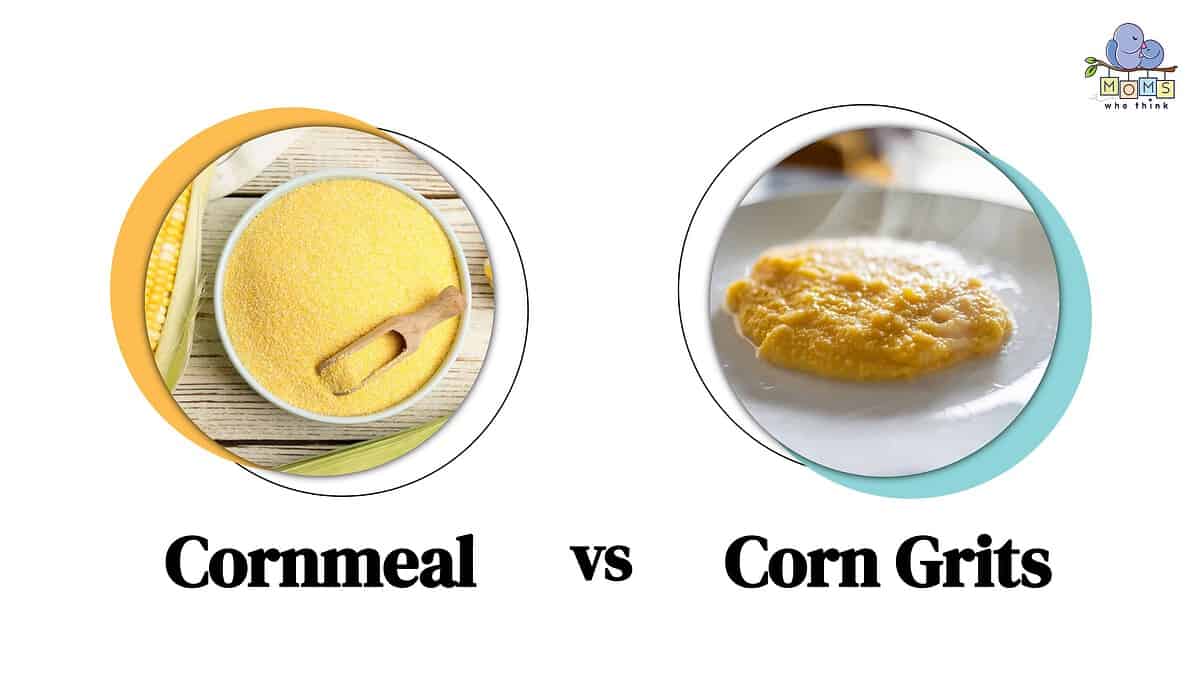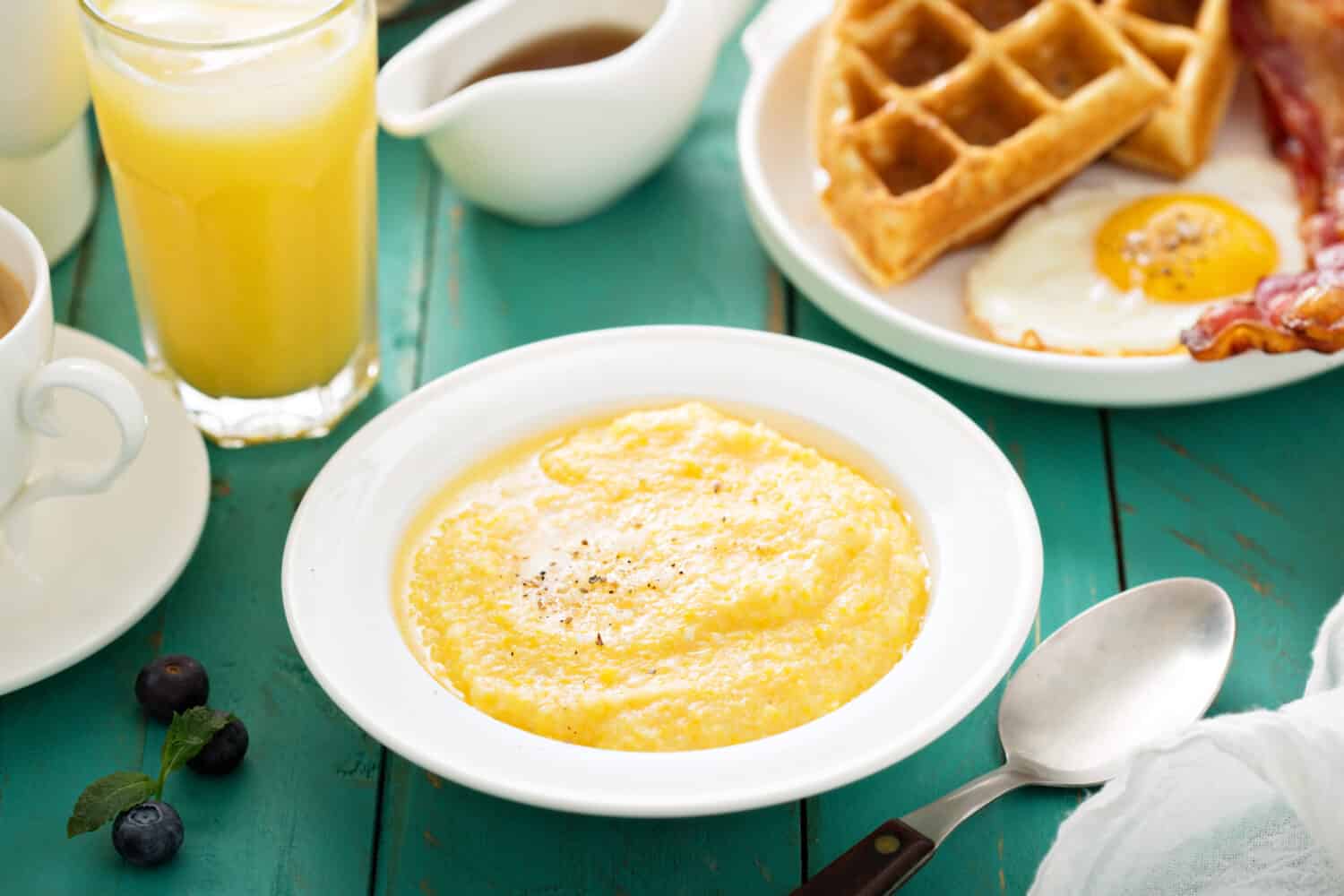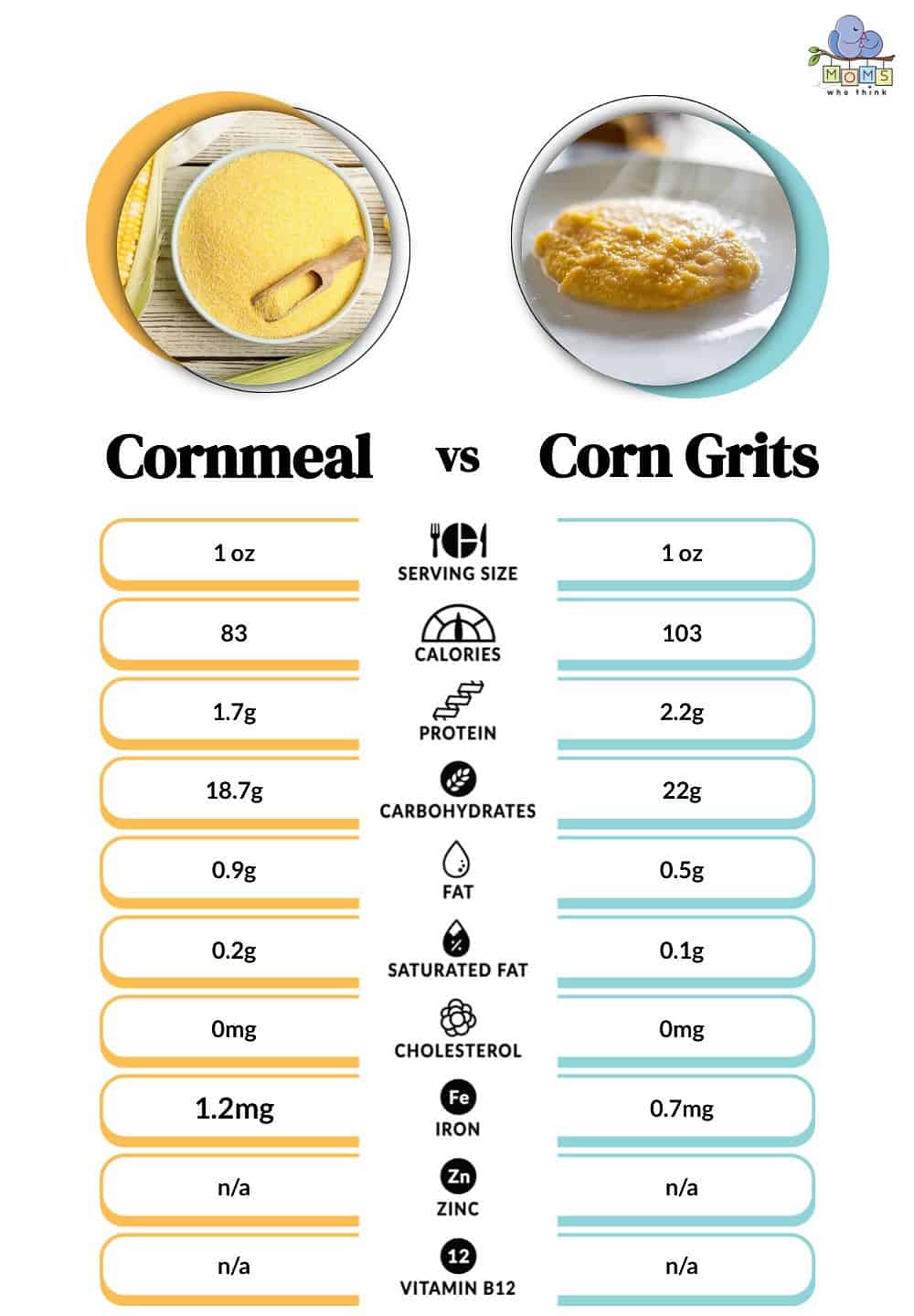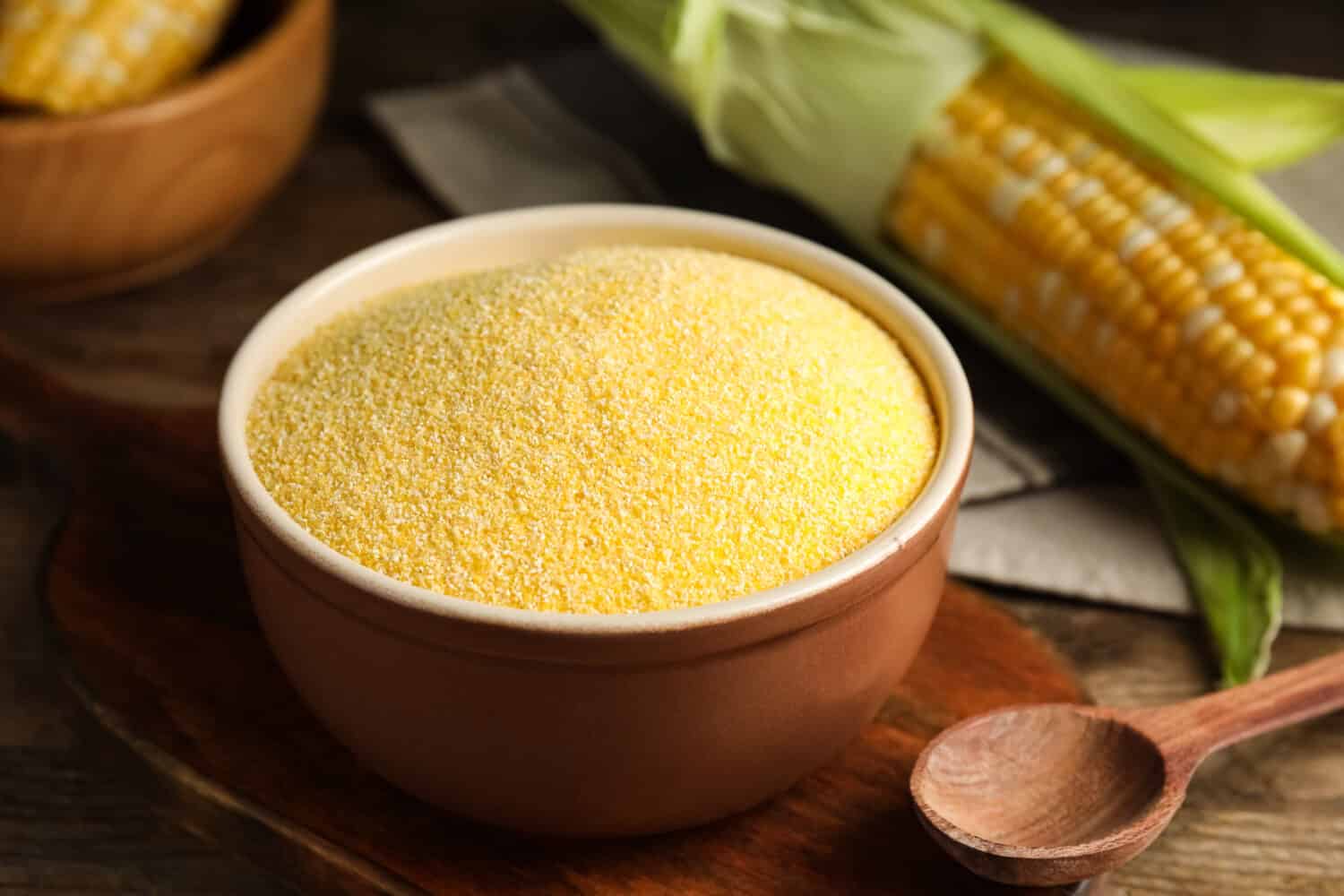Corn is a healthy and popular food item used by people all around the world. But it can be produced in different ways and used variously in the kitchen. One example is cornmeal and corn grits. Sitting next to each other on the grocery shelf, they may seem identical. So what sets them apart?
One main difference between the two is how they are ground. Cornmeal tends to be ground finely when manufactured for the grocery store while corn grits are typically sold medium or coarsely ground.
Today, we'll take an in-depth look into the main differences between cornmeal and corn grits. If you're curious about how these two corn products can be used successfully in the kitchen and how they compare nutritionally, we've got you covered. Let's dive in!

©
What is Cornmeal?
While sweet corn is something we eat straight from the cob, field corn is a different story. Cornmeal is a bi-product of dried corn that's been milled and ground. While cornmeal can be ground in varying ways from course to fine, the finely ground option is what you'll likely find in your local grocery store.
Cornmeal is not quite as fine as corn flour, but it's more fine than corn grits. This slightly grainy texture makes it the key ingredient in cornbread and corn muffins. Cornmeal is sometimes referred to as a “course flour” and is generally yellow in color. There are different types of cornmeal, however.
Types of Cornmeal
Because cornmeal can vary in how it's ground and what type of corn is used to produce it, there are varying types you may find available to purchase.
- Yellow cornmeal is the most commonly used and is finely ground using the entire kernel. This type is likely what you'll see on grocery store shelves.
- White cornmeal is almost identical to yellow cornmeal except that it's made from white corn which gives it a lighter hue.
- Blue cornmeal is made from blue heirloom corn typically found in the American South. It has a slightly sweeter flavor and appears blue or violet in color.
What are Corn Grits?
Corn grits are a common food item you'll find in the Southern states of the U.S. This food product is also generated from field corn but goes through a special soaking process before being ground. In order to make corn grits, the corn on the cob must first be soaked in lye or an alkali solution which removes the hull of each kernel. This is referred to as hominy and is creamier and smoother when cooked.
The hominy that's used to make corn grits is also sometimes called “dent” corn. This refers to the dent that's left in each kernel after it's dried. Corn grits are often cooked up on their own with butter and cheese as a side dish or breakfast item.
Types of Corn Grits
When it comes to cooking corn grits, you may find different options available on the market. Corn grits can vary in how coarsely they're ground as well as how quickly they cook.
- Instant corn grits are similar to minute rice and cook for 5 to 10 minutes. Keep in mind that while instant grits may be more convenient, they tend to come with a lower nutrient value since they are partially cooked before drying and more processed.
- Stone-ground grits can take about 45 minutes to cook but are higher in nutrients and considered whole grain because they retain the germ found within the corn.

©Elena Veselova/Shutterstock.com
How to Cook Corn Grits
While cornmeal is an ingredient used in various recipes, corn grits can be easily cooked on their own as a side dish. They are simmered in salted water or milk until thick and smooth. After they're cooked, butter, cheese, cream, or various other ingredients may be added to increase flavor and variety.
Cornmeal vs. Corn Grits: What are the Differences?
As mentioned, cornmeal and corn grits differ in how coarsely they're ground. But since they both come from corn, how else are they different? Here are 3 key differences:
Origin
Cornmeal has a rich history in the United States. Indigenous people were grinding maize before the Europeans even made land here and its roots date back to 5000 BC Mexico according to World-FoodHistory.com. Because corn was easily grown in the United States, colonists learned how to grind corn and use it in food items upon their arrival here.
Grits have a similar origin story as cornmeal, but their roots are more centralized in Southeastern states. According to RealSimple.com, The Native American Muskogee tribes located in Tennessee, Alabama, Georgia, and Florida were using corn grits in their food during the 16th century.
Taste and Texture
Cornmeal and corn grits have differing tastes and textures as well. Cornmeal is finely ground and used as more of a flour ingredient in baked and fried foods. It may have a slightly grainy texture but doesn't have much flavor.
Corn grits, on the other hand, are smooth, thick, and mushy when cooked. They also have a mild flavor and tend to taste like what you mix with them. This is why butter, salt, and cheese are often added to grits in order to boost their flavoring.
Uses
As we've briefly mentioned, cornmeal and corn grits are used differently in the kitchen. Cornmeal is a versatile ingredient that is most popularly used to make cornbread and muffins. But it can also be used to dust baking surfaces for food items like pizza and bread, or as part of a batter for deep-fried foods like mozzarella sticks and chicken strips.
Corn grits are not quite as versatile, however. They are typically cooked on their own as a side dish with added ingredients. Popular recipes include cheese grits, shrimp and grits, and various casseroles.
Cornmeal vs. Corn Grits: Nutritional Value
Cornmeal and corn grits both derive from corn and have similar nutritional value. Keep in mind that these numbers can change depending on the type and variety of each product you choose. In general, corn grits have slightly more calories and carbs than cornmeal. But they also offer more protein and less fat.

©
Can you Substitute Cornmeal for Corn Grits and Vice Versa?
You can! Even though these two products have a different texture when finished, they're both derived from corn and offer a similar mild flavor. However, it's important to note that substituting one for the other may alter the finished texture and consistency of your recipe. Let's look at a few other great substitutes for both of these corn products.
Other Substitutes for Cornmeal
Because cornmeal is often finely ground, substitutes are more flour-based. A few options include:
- Corn flour
- Polenta
- Almond, coconut, or wheat flour
- Oats
- Ground flaxseed
Other Substitutes for Corn Grits
When cooked, corn grits are typically thick and smooth. They also vary in how they're being served. Keep in mind that if you're preparing grits for breakfast you may want to choose a more breakfast-type substitute. But if you're using them for a side dish, consider other side dish options. Here are a few corn grit substitutes:
- Cream of wheat
- Oatmeal
- Polenta
- Risotto
- Mashed potatoes
Final Thoughts
Cornmeal and corn grits are both delicious corn bi-products that can be used in various ways. The biggest difference is that cornmeal is finely ground while corn grits are often medium or coarsely ground. Each one offers its own unique use in the kitchen with differing tastes and textures. From cornbread to cheesy grits, both cornmeal and corn grits can give your next meal a delicious and healthy twist!
The image featured at the top of this post is ©New Africa/Shutterstock.com.

